What Is Mongolian Food? Going Beyond the BBQ
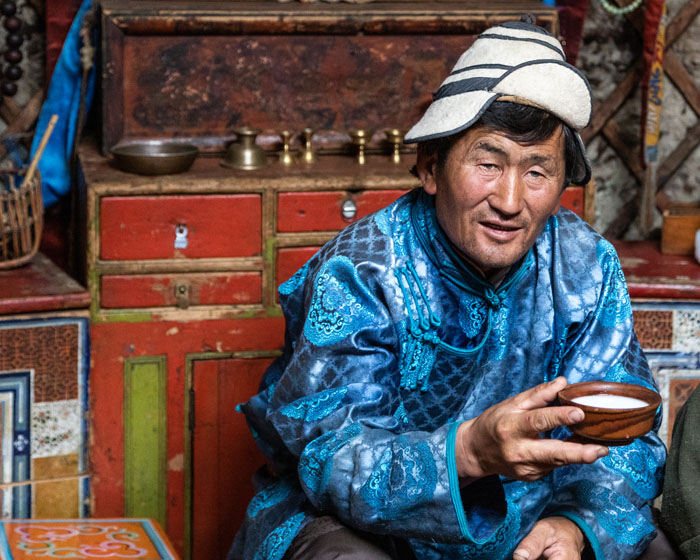
Mongolian food isn’t “Mongolian BBQ.” It’s meat and dumplings, dried curd and milk tea. Here’s what to know about local cuisine and culture in Mongolia.

Airag is a traditional drink in Mongolia. All photos courtesy of Kari Kozak Dahlstrom.
Say Mongolian food and the first thing that comes to mind is probably a modern chain restaurant. I mean, who doesn’t love a 20-foot, all-you-can-eat buffet filled with raw meat, fresh veggies, and concoct-your-own sauce? Add the excitement of a wannabe-ninja chef cooking on a 500-degree flat top grill, and you’ve got a fun and tasty dining experience. Toss in a raw egg and marvel as the chef expertly cracks and fries it with shiny three-foot tongs.
However, not only is “Mongolian barbecue” not really BBQ; it’s not actually Mongolian either. It was invented by a Taiwanese man in Beijing and brought to Mongolia by an American company. The first U.S. franchise to open in Mongolia, in 2005, BD’s Mongolian Barbeque brought this dining concept to the capital city of Ulaanbaatar. The bright, modern restaurant located in the central Sukhbaatar district features a full bar plus a wide selection of salads and desserts to accompany your main course.
So what IS actual traditional Mongolian food? I traveled the country to learn more about it, and to experience the richness of Mongolian cuisine and culture.

Food prep in western Mongolia.
Traditional Mongolian Food of the Nomads
To taste real-deal Mongolian BBQ, you have to head to the countryside. My local guide, Oso, from Nomadic Tours Asia, arranged a stay at Ar Burd Sand Camp located on a sandy steppe 140 kilometers south of Ulaanbaatar.
Traditional Mongolian “barbecue,” called khorkhog, is nothing like its modern cousin. A rural dish typically served for special occasions, khorkhog is made by cutting the meat of a sheep, goat, or camel into chunks. The meat is layered in a pressure cooker with large round stones that have been heated in a fire. A small amount of water is placed at the bottom of the cooker, then the meat, hot stones, salt and pepper, and sometimes vegetables such as cabbage and onion. The layering continues until the pot is full. It is then sealed and placed on a fire to cook for several hours.
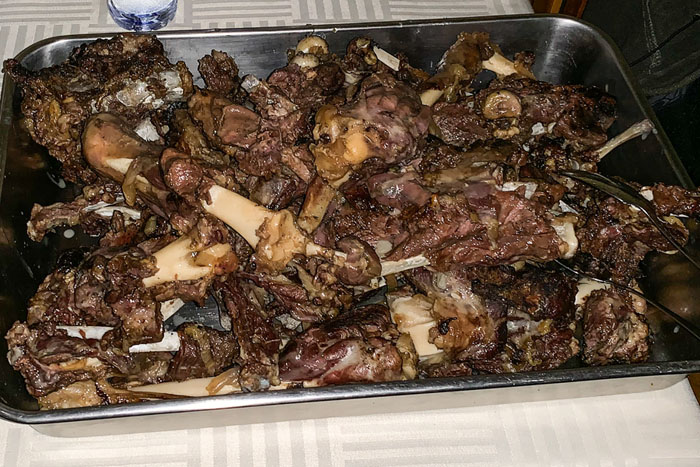
A tray of khorkhog once removed from the pot.
This cooking method lets the heat cook the meat from both inside and outside the pot, ensuring an even cook. Our khorkhog was made with a full-grown sheep that had been slaughtered earlier in the day (side note: Mongolians never eat lamb). After a semi-dramatic pot opening (see the video, below), the meat was served with roasted broccoli, some of the best potatoes I’ve ever eaten, and a fresh salad.
Also served with the meal was the all-important buuz, a pinched steamed dumpling filled with meat, which Mongolians eat at least once a week. The tasty dumplings are believed to be good for health and are always eaten by hand, never with a fork. Also considered good for health and circulation is the tradition of holding the warm rocks from the khorkhog kettle.
One of my guides, Boogii (short for Bolortuya, which means crystal and light), explained that buuz are especially important when family ties are renewed during Lunar New Year (Tsagaan Sar) celebrations. During this time, each family makes 1,000 to 2,000 mutton dumplings, which they freeze outside until it’s time to serve. (Ulaanbaatar is the world’s coldest capital, with an average January temperature of -24°C, or -11°F.) When guests arrive, the dumplings are steamed in a rice cooker for 15-20 minutes. Each time a new guest arrives, more buuz are steamed—and the guests must eat them, as it’s impolite to refuse.
And who’d want to refuse these yummy bundles of goodness anyway?

A plate of khorkhog and buuz (bottom center), plus veggies and amazing potatoes.
Food isn’t the only Mongolian tradition you’ll experience if you visit Ar Burd. You’ll sleep in one of 15 traditional Mongolian gers (yurts) made from wooden lattice covered by wool felt. Quickly set up and taken down, nomadic families have lived in gers for centuries, moving them across the countryside as they grazed their herds. At Ar Burd, you can also ride a two-humped Bactrian camel and have your photo taken in traditional clothing.
Another ger camp with great Mongolian cuisine is Mongol Nomadic Camp, just 55 kilometers west of UB. I knew I was in for an exceptional experience when the greeting party included five yaks, two camels, and two horses ridden by local men dressed in traditional deel clothing (robe-like tunics worn for centuries in Mongolia). A young man in bright orange boosted me onto a 1,300-pound shaggy black-haired mound of muscle, and I gazed through three feet of twisted yak horn as we sauntered down the sloping landscape to the nomadic camp.

Mongol Nomadic Camp
Off the yak, I was escorted inside a family ger setup to share Mongolian culture with other curious visitors. The elder male of the family sat directly across from the door dressed in a shiny royal blue deel, embellished black trousers, and tan boots with turned-up toes. His wife, stunning in bright red, poured milk tea (known as süütei tsai or tsutai tsai) from a thermos into small white bowls.
I was instructed to accept the bowl with both hands and sip it when it was handed to me—it’s impolite not to taste food that is offered. Mongolians drink this cow, camel, or sheep milk with tea and salt up to three times a day.

Aaruul and boortsog.
On the table was a large bowl of aaruul, dried curd so hard it’s often sucked rather than chewed. Aaruul is made from cow, yak, or camel milk that has been left to curdle. The solids are removed and the liquid drained off. What remains is formed into a cake and pressed, dried in the sun, and cut into small pieces. The flavor is like sour milk with a hint of sweetness. Because aaruul can last indefinitely, it is a perfect source of nutrition out in the Mongolian countryside. When paired with the dried meat called borts, a nomadic family has food to last throughout the difficult winter.
Next to the aaruul was a wooden bowl full of fried dough, called boortsog. Like a doughnut but less sweet, boortsog is made in different shapes and sizes and often dipped in tea or butter. Mine was served with a sour yogurt that helped moisten its otherwise dry consistency.
As I sampled the snacks, a young man sat down and began playing a traditional horsehead fiddle. When he opened his mouth, the most amazing sound came out. For the next few minutes, I was completely transfixed by the incredibly deep, melodic tones of Mongolian throat singing. This unique artform takes years to master and involves the ability to sustain multiple notes for long periods of time through a specialized breathing technique.
Soon the family elder began a drinking game, choosing another visitor—Dolly, a retired police officer from California—as his partner. The man and Dolly each popped up various fingers in a sort of rock, paper, scissors game. When Dolly lost, her penalty was to drink vodka out of an animal horn.
Vodka, Vodka, and More Vodka
Vodka is the most common alcohol in Mongolia—in fact, some claim it may have originated there. While its true origin cannot be verified, Mongolians have been making vodka for centuries. Out in the countryside, nomadic families make their own style of vodka called airag. Also known as koumiss, airag has an alcoholic content of 3 to 5 percent and is made from fermented mare’s milk. It is cloudy white and has a slightly sour taste with just a bit of sweetness.

Mongolians love their vodka: store shelves in Ulaanbaatar.
As with milk tea, each region’s version is different based upon the grass on which the horse has grazed. The Bulgan province, just west of the capital, is known for its high-quality airag. Some visitors travel to Mongolia just to try airag and its cousin, arkhi, a more potent, distilled version made from cow, yak, or goat milk.
In UB and other cities, grocery stores display shelf after shelf of shiny bottles of mass-produced, clear vodkas. Chinggis, Eden, and Soyombo are popular brands. Local restaurants and hotel bars offer vast menus of vodka choices that can be served straight up or in mixed drinks. To enjoy a view with your cocktail, head to the bar on the 25th floor of the Best Western Premier Tuushin hotel (map) or to the superchic Blue Sky Lounge atop Blue Sky Tower (map), both in UB’s central Sukhbaatar district.
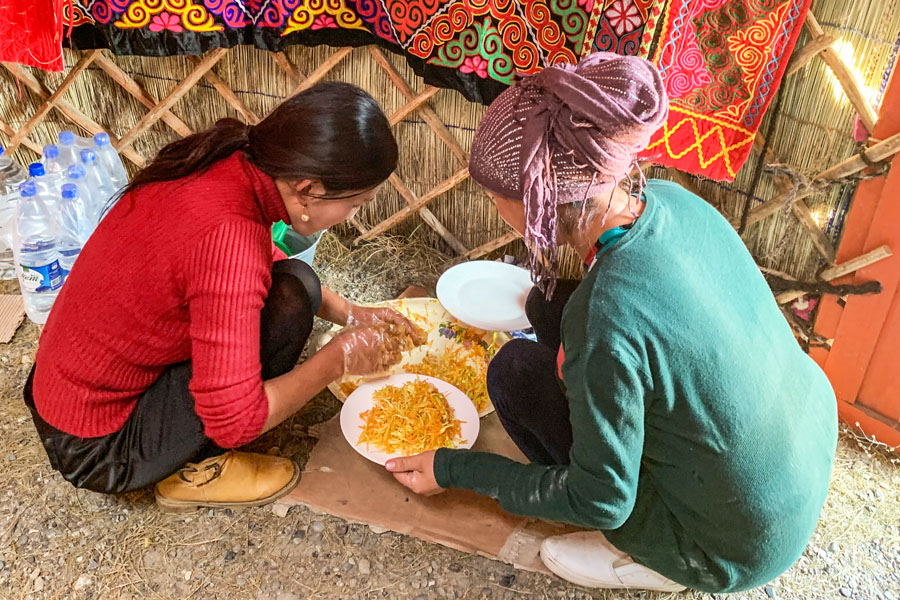
Kazakh women prepare food in western Mongolia.
Mongolia’s Kazakh Cuisine
Like many tourists, I visited Mongolia to attend the Golden Eagle Festival, made famous by the movie The Eagle Huntress. The annual event is held in the westernmost province, Bayan-Ölgii, about 1,200 miles and a three-hour flight from UB.
This part of Mongolia nearly noses up to Kazakhstan and is home to thousands of Kazakh people. At the festival, hunters of all ages demonstrate their heritage using golden eagles to hunt for small animals. Mounted on horseback, the hunters call their eagles from high atop a mountain and receive points for speed and accuracy as their eagle returns to them.
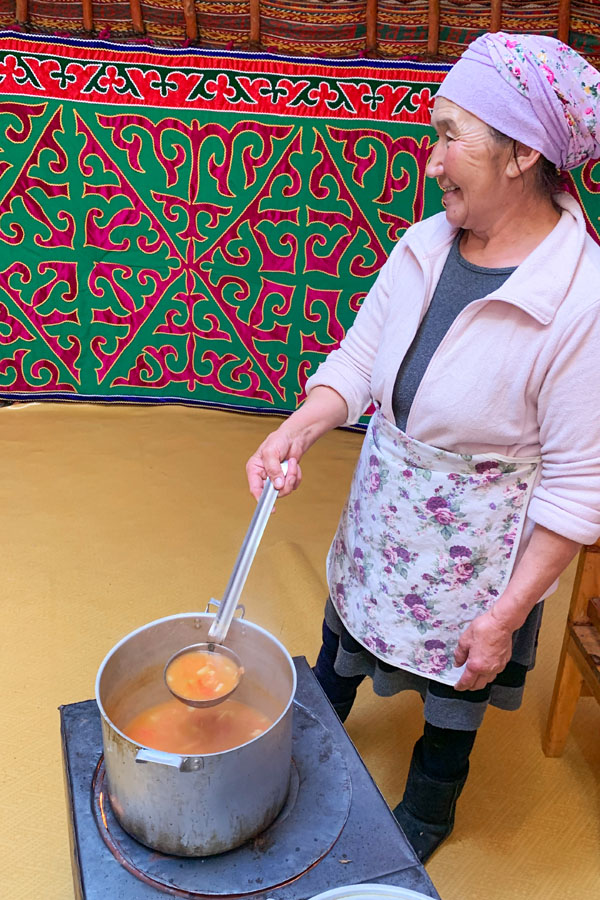
A Kazakh woman shows off her stew in western Mongolia.
Mongolia’s largest ethnic minority population, the Kazakhs are culturally different from Mongolians in language, religion, music, and food. Like Mongolians, Kazakhs rarely eat meals without meat. However, being Muslim in faith, the Kazakhs’ meat is halal. In western Mongolia, meat is generally boiled or slow-cooked for several hours and prepared with more spice. Cabbage, potatoes, and onions are common and may be cooked with or served alongside the meat.
On my way to the festival, I stayed at a traditional ger camp along the Khovd River with a group of fellow photographers. At our riverside camp, the head chef and her daughter-in-law served us delicious meals cooked over a coal-burning stove. The dining ger was filled with tremendous smells as hearty soups and steaming stews bubbled away until the mutton or beef and vegetables were tender. Our meals were accompanied by crunchy cabbage slaws, sliced cucumbers, and ripe tomatoes.

Kazakh manti in western Mongolia.
The Kazakhs have their own version of a meat-filled dumpling. Called manti (as in Turkey),the dumplings are typically filled with a spiced ground beef or mutton mixture. The meat is placed in the center and the supple dough expertly pinched before boiling or steaming. Each and every day our kind chefs doted over their carefully crafted manti.

Rolling out the manti.
One afternoon we had the tremendous opportunity to photograph a group of eagle hunters out in the countryside and visit their family’s ger camp. While at camp, we were served the most popular traditional Kazakh dish, called besbarmak. The name translates to “five fingers,” indicating that the dish is eaten with the hands. Besbarmak consists of meat, broth, and pasta. Ours was plated with boiled potatoes and accompanied by a vegetable slaw, baursak (a fried dough similar to boortsog), and large chunks of dried sour cream called kurt, which is similar to Mongolian aaruul.
.jpg)
Kazakh food in western Mongolia.
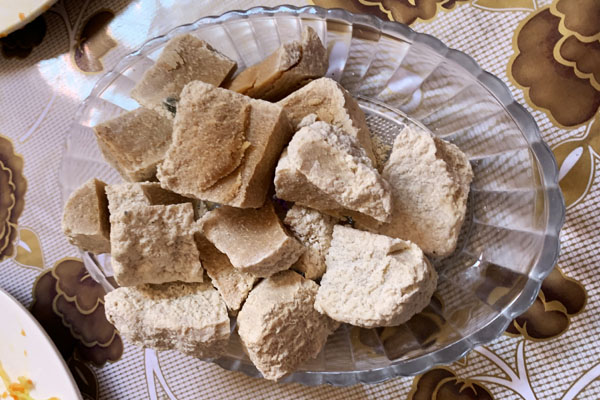
Kurt
After the meal, one of the eagle hunters played a hollow stringed instrument called the dombra and sang folk songs for us. The day was an incredible invitation to soak up the local culture through food and music. Though we didn’t speak the same language, we made a human connection as we discovered the eagle hunters’ way of life.
Where to Eat in Ulaanbaatar
By now you’ve probably noticed this is a meat-heavy cuisine—that’s thanks to Mongolia’s nomadic history and extreme climate. After all, it’s hard to grow vegetables if you are continually moving your herd in an extremely harsh landscape.
Back in Ulaanbaatar for a few days, I had the chance to check out some contemporary restaurants, where meat remains popular. With 1.5 million citizens—that’s half the entire country’s population—UB has no shortage of places to get a hearty meal, traditional or not. Adventurous carnivores will love Khainag Grill (map) and its variety of organic meats, including beef, camel, goat, horse, lamb, pork, and yak. Diners can choose one or get the chef’s tasting with four types of protein. The meat is cooked right at the table, either by the diners themselves (don an apron and get to grillin’) or by the in-house chef. The restaurant, situated on the 27th floor of the four-star Khuvsgul Lake Hotel, has incredible views too, as it’s right next to the coolest rooftop terrace featuring one of the city’s three helicopter pads.
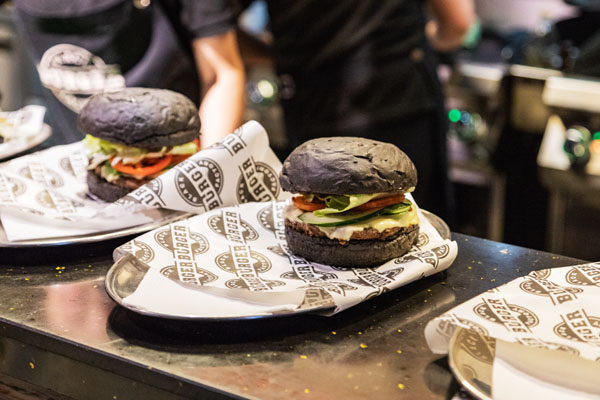
Black Burger in UB.
One of my favorite UB spots was much less adventurous, but just as meaty. Black Burger Factory (map), a contemporary burger joint, offers several choices of burgers and wraps, some served on a signature black bun made with squid ink. I loved the steak burger with marinated chunks of tender steak, cucumbers, jalapeño, and spicy sauce. As a fun gimmick, Black Burger offers diners a pair of black plastic gloves to keep their hands clean while eating the messy burgers. Poultry and, yes, even veggie and vegan options are also available.
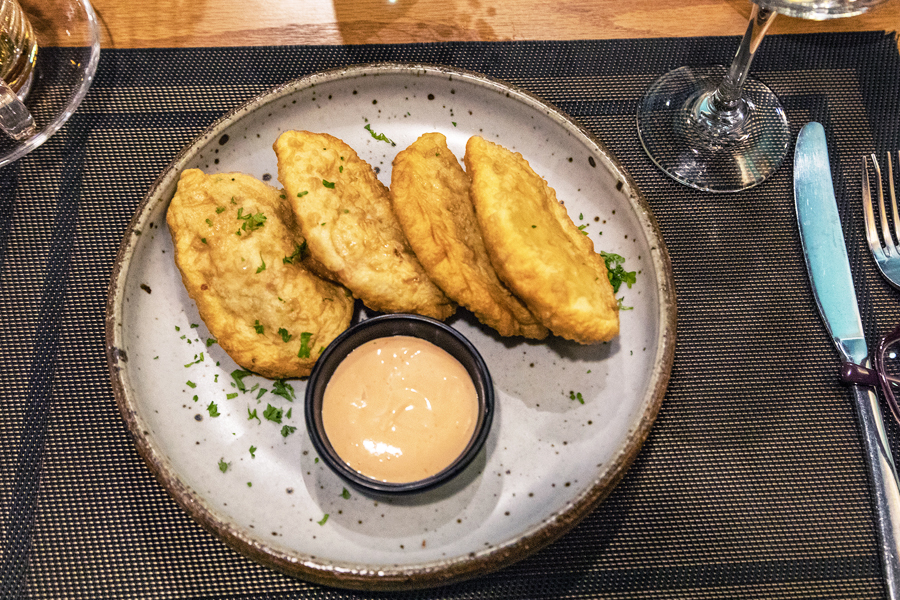
Khuushuur in UB.
For an upscale dining experience, I liked Route 22 Restaurant and Wine Lounge (map), not far from Sukhbaatar Square. Its extensive menu features both Mongolian and international fare. Here you can find the traditional meat pie called khuushuur: fried dough filled with minced mutton, salt, and onions, served here with a mild sauce on the side plus a dinner salad. As the name implies, Route 22 features an extensive wine list too, including some Mongolian options.
Mongolia is a travel destination like no other, with remarkable landscapes, genuine people, rich traditions—and relatively few tourists. Whether you head to Ulaanbaatar or spend time in the vast countryside, the traditional and modern Mongolian cuisine is well worth exploring. The city, of course, is easier to navigate, as most attractions are centrally located. But the rewards are rich when traveling the countryside, where you’ll want a guide to help you navigate the roadless terrain. There’s never been a better time to discover all this country has to offer.
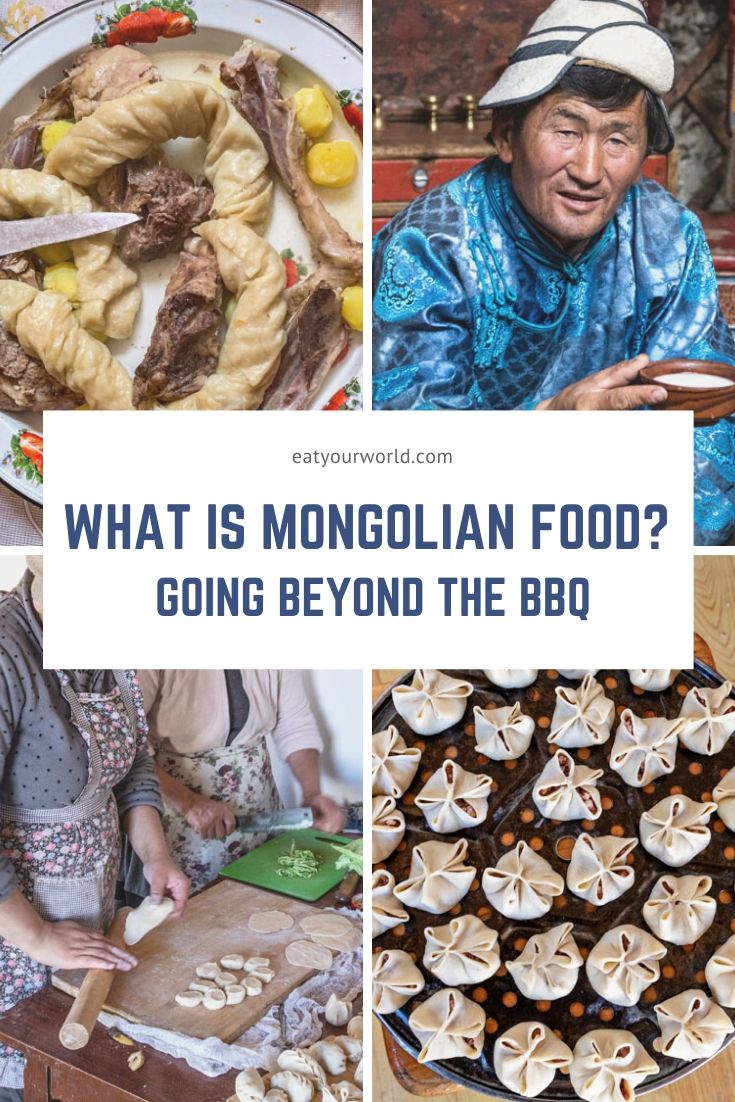
Pin this to save!
About the author: Kari Kozak Dahlstrom is a traveler, writer and photographer based in Tacoma, Washington. When it comes to travel adventures, her motto is, “Do it!” Follow Kari on Instagram @Kari_Dahlstrom_photography.



Most of this article is about Kazakh food, which is at least passable. Actual Mongolian food is one of the worst cuisines in the world (possibly THE worst), everyone who’s familiar with it knows that, and you were really digging deep trying to write this article.
The author is quite clear about what the Kazakh food influence is, and writing about a culture’s traditional foods is hardly “digging deep.” The author never says it’s the best cuisine in the world, for the record, but she genuinely appreciated learning about Mongolian culture via the food and other traditions she experienced.